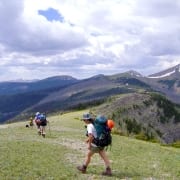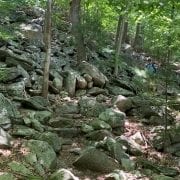How many times in our lives do we stand at a place where all things seem lost? These times of distress are inevitable and will visit all, both the weak and the mighty.
“Rise up, walk through the length and breadth of the land, for I will give it to you.”
– Genesis [13:17]
WALKING THE LENGTH AND BREADTH OF OUR FAITH
The great father of our religious heritage, Abraham, was from the tenth generation since Noah. His father, Terah, had taken Abraham from his home in Ur, to journey through the land of the Canaanites. His father never made it into Canaan. Distracted from his mission, stopping instead in Haran, where Teran died.
After his father’s death, Abraham was spoken to by God, who said; “Go from your country and your kindred and your father’s house to the land that I will show you.” – Genesis 12:1 Abraham began a long journey throughout the region, taking with him, his immediate family and nephew Lot. Along the way, they were beset by many struggles, including a famine. Desperate to avoid the loss of his health and wealth, forgetting God’s command, Abraham led them into Egypt. Abraham like his father became distracted and lacking in faith moved away from God’s plan.
While in Egypt, Abraham told his wife, Sarah, to tell Pharaoh that she was his sister. An act of concealment to avoid having Abraham being murdered. For his wife, Sarah was beautiful and Abraham was sure that Pharaoh would murder him to possess his wife.
The plan worked for a while, Sarah was fully accepted in Pharaoh’s house. Abraham was treated well by the Egyptians. Pharaoh takes Sarah as his wife, but soon develops sore and other plagues caused by God. Pharaoh confronts Abraham and asks him why did he lie? Why did he not tell Pharaoh that Sarah was his wife? Fearing more retribution from God, Pharaoh him banished from Egypt.
Along the way, both Abraham’s and Lot’s herds grew. Causing animosity between Abraham and Lot. Abraham tells Lot to choose a place where he would go and Abraham would take what was left. Lot chose a large parcel of land that would be best for his herds but also contained the city of Sodom. A place that was notorious for its wickedness and sinful behavior.
Lot moved his herds and settled in the city of Sodom. Abraham took over what was left. A final settlement and finally Abraham was in the land that God wanted him to be. After years of traveling to Canaan and being distracted by his own fears and hearing the sirens of other lands. Abraham was where God wanted him.
God then issued a request to Abraham to, “ “Rise up, walk through the length and breadth of the land, for I will give it to you.” – Genesis [13:17] Abraham was now finally where he should be and God had told him to inspect all that he owned. Not just to see, but walk its length and breadth. To immerse himself in all that God was giving him. Not just see the trees and water, but to be with the land. To explore every facet of this land that he had inherited from God.
Metaphorically, we can see this same thing in our lives. Our faith is the land that God wants us to explore and become immersed. Not just stand by and watch the unfurling of our faith, but to experience and invest our energy into our faith. To move beyond just saying our prayers and reading the Bible. But to explore our prayers and the Bible. To become deeply immersed. To learn the ways of the world and what to avoid. To wonder at the majesty of all creation. To wonder about the stars, to observe the spiritual winds of our lives. To not become attached to the shiny and temporary glimmers that the ways of the world. To not live our lives in fear and desperately try on our own to solve our problems through worldly ways.
God has a great bounty of spiritual wealth awaiting us. God will protect us and guide us on this journey. In times of trial he will hear. We will never be alone.
Blessings, until next time,
Bruce L. Hartman
The Geology of the Appalachian Trail
We decided to take a one week vacation from walking the trail. After arriving in Pennsylvania, our seventh state, we found our knees worn out and suffering from our third sickness. We will be skipping the rocky terrain of Pennsylvania and moving up to New Jersey to stay on schedule. We will come back to PA in the fall.
In just a few days of resting, we found ourselves missing our trail life and having a defined daily purpose. We missed the other hikers we have grown to know and the simple daily existence. But we found our ankles and knees were sore from the daily grind. Before we took our mini hiatus we had walked almost 14 days in a row. Mostly finding rocks that litter the trail.
We had been told that when we hit Virginia that the trail got easier. Certainly, the climbs were lower and our legs were much stronger. But we kept asking ourselves, “when does Virginia get easier?” The further north we walked, the greater the number of rocks and large boulders. Slowing our pace and creating unwanted falls. One day, in particular, we had to descend a half mile rock fall. A steep drop where each step had to be strategically thought out. It made me wonder, why the difference in terrain conditions versus the southern part of the trail.
In my research, I discovered why.
It wasn’t that the trail was less maintained, but by the geology of the trail. The Appalachian mountains are close to five hundred millions years old. Some geologist claim they are the oldest mountains in the world. They are four times as old as the Rockies and the Sierra Nevada’s.
Erosion and glaciers have reduced the size of the Appalachian mountains over these many years and created the steeper up hills and down hills. The average grade on the trail is over two hundred feet per mile, while the Pacific Coast and Continental Divide trail are far less, at over one hundred feet per mile. While the Rockies are higher and its largest peaks are fourteen thousand feet high, the trails are graded to handle livestock movement. As such most climbs are no greater than 11%. Whereas on the Appalachian Trail, many climbs are 20% in total with some sections reaching 40%!
So while the highest point in the Appalachian Mountains is Mount Mitchell at 6,600 feet, the steepness of the grade is the difficulty. Added on to this is the many years of erosion and the effect of numerous glaciers.
The erosion in the southern part is not as severe as the northern part, as the glaciers only reached the Ohio Valley. Their effect was to remove the topsoil and leave the rocks. Many of the rocks were pushed forward during the many ice ages. When you look at the topography of the Appalachian Trail on a map, which we did in Harpers Ferry, you see the Appalachian mountains are wider in the south and generally much higher.
The northern two states, Maine and New Hampshire, have some high peaks but are generally a thousand feet smaller. What these two states do have are much steeper climbs. In many places the climbs are over a thousand feet per mile, making both the ascent and descent hard. Even experienced hikers slow to a pace of one mile per hour.
Virginia Discovery
What we discovered in Virginia was not an easier trail, but a different trail. Our new obstacles were granite rocks that were left behind from the erosion. We also discovered the ridges were narrower and the valleys more fertile. Farms dotted the landscape and on some days we even walked through farms.
As we entered the three states of West Virginia, Maryland and Pennsylvania, the rocks became more frequent. The boulder fields were longer and bigger. In the southern part of Virginia and Tennessee, we could easily walk well over 2 miles an hour, or the average speed of the typical hiker on the Appalachian Trail. We actually slowed going north to just at 2 miles an hour. While not as exhausting as the steep climbs in the south, our hiking is more technical. Each step has to be carefully watched.
What we have learned is not to trust the small rocks, they will move and cause you to roll your ankles. Connie discovered that looking for the big boulders and charting a course among them was far easier. When the rocks are wet, they are greasy and rounded or sharp rocks need to be avoided or a slip and fall will occur.
So while we were told, when you hit Virginia the trail gets easier, we did not find this to be true. Sure the climbs weren’t as high, but the walking was harder because of the rocks. While our legs are much stronger, our walk is more measured.
We missed the trail and have returned this week. We needed the time off, to rest and let our knees recover. Our lesson we learned, is to be more careful with what we try to accomplish. To be more careful in planning out our days. To bring to the trail more from the outside, like friends and our other interests. A blending of the outside world with trail life.
Blessings, until next time,
Bruce L. Hartman
“One thing I do know, that though I was blind, now I see.”
— John [9:25]
GAINING OUR SIGHT THROUGH JESUS
The backstory for John [9:25] reveals a person who was blind from birth, whom Jesus heals. The man is begging on the side of the road when Jesus sees him. The disciples ask Jesus if the beggar is blind because he was sinful, or were his parents sinful? Here Jesus begins his lesson.
They met the blind beggar on the Sabbath. To begin this lesson Jesus picks up mud and rubs it on the eyes of the blind man and tells him, “Go, wash in the pool of Siloam.” (John 9:7). The man goes to the Siloam pool, which was just outside the city of Jerusalem. (The pool was recently rediscovered in 2004 by workers working on the underground plumbing systems of the city.) After washing, the man can see, and he returns to his community, the members of which see the change in him. They are extraordinarily doubtful, wondering among themselves if this could be real, or was it someone else they were meeting that looked like the blind man? Ironically, this same doubt occurs frequently even today with those who are spiritually reborn. Their neighbors and friends, stuck in the past, wonder how the person could have been saved. They are not willing to completely commit to the person’s transformation.
After a long period of questioning, the people of his community ask the formerly blind man where Jesus is now, and the man answers, “I do not know.” (John [9:12]) The crowd brings the man to the Pharisees, who also doubt and ask numerous questions. The Pharisees strangely focus on the fact that the healing occurred on the Sabbath, a clear sign to them that Jesus was a sinner. In the minds of the Pharisees this was the path to follow in determining the authenticity of the healing.
The Pharisees then question the man’s parents, who confirm that he was blind at birth. Not wanting to risk their status within the community, they avoid expressing any opinion about their son’s healing and tell the Pharisees to talk to him directly. The Pharisees visit the formerly blind man a second time and question him more aggressively. Trying to force the man to acknowledge that God healed him and not Jesus, they say to him, “Give glory to God! We know this man is a sinner.” (John [9:24]). Still stuck on the fact that the healing was done on the Sabbath, the Pharisees are more interested in discrediting Jesus than in understanding the healing. The man replies, “I do not know whether he is a sinner. One thing I do know, that though I was blind, now I see.” (John [9:25])
Frustrated the blind man says, “Here is an astonishing thing! You do not know where he comes from, and yet he opened my eyes. We know that God does not listen to sinners, but he does listen to one who worships him and obeys his will. Never since the world began has it been heard that anyone opened the eyes of a person born blind. If this man were not from God, he could do nothing.” (John [9:30]–33)
Unwilling to accept this rebuke from the saved blind man, the Pharisees drive him out of his community. Imagine how we would feel, if suddenly we were physically or spiritually healed and then we were subjected to this kind of doubt and questioning. The blind man, after a lifetime of being blind, no doubt imagined that those that surrounded him would be overjoyed at his sudden regaining of sight. We readers of this story can easily sympathize with the blind man and wonder why the Pharisees or his community could not come to terms with the fact that Jesus healed the man.
For those who were blind and now see, this is a common issue. Many will not believe that the supernatural change and healing in them came from an honorable cause. There must be some trick to it, more than just a change of heart or a healing. With Jesus that is all there is. As the blind beggar said so simply when asked how he was healed, “I do not know whether he is a sinner. One thing I do know, that though I was blind, now I see.”
Blessings, until next time,
Bruce L. Hartman
How many times in our lives do we stand at a place where all things seem lost? These times of distress are inevitable and will visit all, both the weak and the mighty.
“Do not worry about anything, but in everything by prayer and supplication with thanksgiving let your request be known to God.”
– Philippians 4:6
THE SIMPLE ELEMENTS OF PRAYER
Prayer is an essential part of developing a strong faith. Through prayer we converse with the sacred and begin a dialogue about our life. We either hear or see responses. At first there might not appear to be answers, but over time they begin to become revealed through the events of our lives as we move deeper in our relationship with God. Our prayer life expands and we stretch out the boundaries of prayer.
As we go deeper, prayer becomes a regular part of our day and our faith is strengthened. We also begin to expand the context of our prayers, leading to a richer prayer and faith life. We begin to see that there are four elements of prayer that can be said as individual prayers or in many cases included together in a single prayer. They are:
- Prayer of Adoration to God. This element reflects our faith in God and the sovereign nature of God. It is also a praising of God. In the Lord’s Prayer, we see it expressed as “Hallowed be thy name.”
- Prayer of Petition. This is where we request and ask for God’s help. Simple words expressing our needs. In the Lord’s Prayer, we see this expressed as “Give us our daily bread.”
- Prayer of Intercession. It is here we are being a good neighbor. We are asking for life assistance for a friend. We are asking God to intercede on behalf of our neighbor. In the verse “Give us our daily bread,” by using the word “us” we are not only asking for ourselves, but also for our neighbor. Prayers of intercession that stand alone usually contain a more direct request.
- Prayer of Thankfulness. This element of prayer is when we take the time to thank God for his involvement in our lives and reflects our gratitude for all that God has done for us.
God wants us to pray with our hearts. Accomplishing this requires an emptying of our thoughts or emerging somehow into a state where we are uniquely alone with God. A place that soothes us and frees our minds for this sacred conversation, centering ourselves to only be focused on God. It is our heart that God wants, free of daily tasks and our to-do list. Many people find a quiet, comfortable place to pray, a routine in the morning that moves them away from the world.
God wants us to be in prayer continuously, and he wants to hear our desires. Being overly prescriptive with our prayer life can make it rigid and meaningless. There are only a few guidelines that I can offer to people who ask me how to pray.
- As it is in the Lord’s Prayer, I suggest always starting with a praising of God. In this statement we recognize the sovereignty of our relationship with God.
- Always treat prayer as a sacred act.
- Ensure that you are in a place and mindset that will be free of distractions.
- Pray through Jesus and recognize the redeeming aspect of Jesus.
- Pray truthfully—God knows the truth about you already!
Praying seems hard at first. We ask what we should pray for? How do we pray? By following these simple steps we can engage in a healthy prayer life. While we should pray in desperate situations, we should also remember to pray with thanksgiving. God wants a full relationship with us, not just in those times of stress, but in all our joys as well. When we pray as if we are an open book we allow a richer conversation with God. A powerful faith is developed through a rich prayer life that in turn honestly observes God’s response.
Blessings, until next time,
Bruce L. Hartman
Weather on the Appalachian
No day starts without knowing the weather when you hike the Appalachian Trail. Recently, I was sitting on the side of the road at a trailhead waiting for a ride. The rain was hard and soaking everything, causing temporary streams to flow in front of me. My pack was covered with my rain cover and I had my rain jacket on. Those parts not covered got extraordinarily wet. My shoes filled up with water and my pants completely soaked. Trees couldn’t protect me, it rained hard. Still, as the water dropped off my cap, I was peaceful and admiring the gift of water. I was comfortable in an uncomfortable spot.
I had checked the weather before I set out and knew it would rain about the time I finished. Sure enough, it arrived as predicted. I was glad I had seen the weather report because the trail was very rocky that day and rain would turn the rocks into a slippery obstacle. A place no hiker would want to be.
It was good that I checked the weather. I knew what was ahead that day. For us, we have walked into and out of the seasons. Many times the weather is different below in the valleys, then at the top of the mountain ridges. So we use the Appalachian Trail weather report. As we walk and the seasons change, we also change our daily preparations.
In hiking the trail, you experience all four seasons; late winter, spring, summer, and fall. At the start, you walk through winter for a few weeks. It’s biggest weather threats are cold, ice and snow. There are days that are delightful in the late winter, any temperature above 50 with no wind or rain is ideal hiking conditions. But we had those nights of cold, where sleeping outdoors is hard. Any exposure of skin was uncomfortable. Early on in our hike, we walked in a gusty wind with temperatures just below freezing, that caused the ice on the trees to pelt us like an unseen machine gun. We had to flee the Smokies just before an unforeseen winter storm, where winter reminded us of the unpredictable nature of its season.
In the spring, we got to see the trail turn from a stark brown to a colorful green. At first, we saw it coming in the form of flowers emerging and in the valleys below that turned green. Slowly it came up to the mountains, day after day. Until one day all the flowers had bloomed and our world was green. Winter doesn’t give up easily and the spring weather will diminish for a few days until it finally takes hold. Hiking in the spring is wonderful, with its just right temperatures and its soft gentle breeze. We no longer had to wear three layers of clothes, on many days walk with only one shirt. The arrival of the newness spring brings excited us and became a tapestry that got more complete every day.
Summer brings warm weather, humidity, and late afternoon storms. The summer causes us to drink more and Gatorade becomes an elixir. The hiking pace slows and requires more stops. The heat and humidity drain our bodies of fluids, causing lethargy that is only solved through good hydration. Summer caught us by surprise. Late in the Shenandoah mountains summer arrived. Humidity and temperatures above 85 became the norm. Some days were above 90. Our only protection was our green tunnel and easier climbs.
Every day we discuss the weather and the forecast. We try to schedule rest days on rainy days. This is not always possible. On the days it rains the trail gets very greasy. Stepping on rocks is like stepping on ice. The ground itself causes us to slip. Cold rain is dangerous and if we aren’t protected, hypothermia can set in.
Every day we look at the weather on the Appalachian Trail site. We have found it to be more accurate than the local weather. The site focuses on the mountains and is arranged by state and shelter. For all of us, it has become the most valuable tool.
Blessings, until next time,
Bruce L. Hartman
“They were amazed, saying, ‘What sort of man is this, that even the winds and the sea obey him?’”
— Matthew [8:27]
WHAT SORT OF MAN IS THIS?
Jesus is sleeping in the cargo hold of a boat that also contains his disciples. From seemingly nowhere the wind picks up and the seas begin to roil. The waves begin to become so large that they threaten to swamp the boat. The disciples begin to panic. Trembling, they awake Jesus and with terror in their voices say, “Lord save us! We are perishing.” Jesus arises and rebukes the disciples by saying, “Why are you afraid, you of little faith?” Immediately Jesus stops the wind and calms the sea. Upon seeing this, the disciples say, “What sort of man is this, that even the winds and the sea obey him?”
What is amazing in this story is the lack of faith of the disciples. By now they had witnessed healing and other miracles by Jesus. They had seen demons cast out, had heard the wonderful Sermon on the Mount, and seen destitute lives changed. We can well wonder, how could they still doubt that they would be saved from the sea? How had they let their human fears override their knowledge of who Jesus was? We in turn can wonder, would we be any different?
Jesus replies with, “Why are you afraid, you of little faith?” His reply contains a universal message about the difficulty of faith. In spite of all they had seen from Jesus, they still allowed their worldly fears to swamp their faith, just as with us, despite all we have seen we allow ours to do the same.
Each time Jesus visits any of us we are left with amazement, many times wondering why we doubted.
Also in this story is a universal question of “What sort of man is this?” Who is Jesus that he calms the wind and seas? Who is Jesus that we can have confidence in him as our savior? While the answer to this question exceeds all humankind’s understanding, we are shown on a regular basis Jesus’s value to humankind. We are told to have faith, because we should. This is easy to mouth, but a simple platitude isn’t enough. Faith, in part, is experiencing and knowing what sort of man this is.
Jesus never gives up on us and will always pursue us to have faith.
Blessings, until next time,
Bruce L. Hartman
Get the FREE "Jesus Is Good For Business" Webinar plus new devotionals each month
Categories
- A Year With God
- Advice
- Business Leaders
- Business Morals
- Challenges
- Christian Ethics
- Christian Leadership
- Effective Delegation
- Friends
- Honesty
- How to be a great employee
- How to Build Your Reputation
- Inspiration
- Jesus and Business
- Jesus and Leadership
- Leadership
- Marketplace Ethics
- Plannning
- Prayer
- Psalms
- Religion and Business
- Successful Christians
- Uncategorized
- Work Ethic







